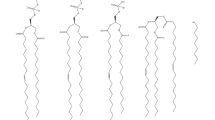Abstract
We present a sub-compartmentalized model of drug distribution in tissue that extends existing approaches based on the well-stirred tissue model. It is specified in terms of differential equations that explicitly account for the drug concentration in erythrocytes, plasma, interstitial and cellular space. Assuming, in addition, steady state drug distribution and by lumping the different sub-compartments, established models to predict tissue-plasma partition coefficients can be derived in an intriguingly simple way. This direct link is exploited to explicitly construct and parameterize the sub-compartmentalized model for moderate to strong bases, acids, neutrals and zwitterions. The derivation highlights the contributions of the different tissue constituents and provides a simple and transparent framework for the construction of novel tissue distribution models.
Similar content being viewed by others
References
Poulin P and Theil FP (2002a). Prediction of pharmacokinetics prior to in vivo studies. II. Generic physiologically based pharmacokinetic models of drug disposition. J Pharm Sci 91: 1358–1370
Theil FP, Guentert TW, Haddad S and Poulin P (2003). Utility of physiologically based pharmacokinetic models to drug development and rational drug discovery candidate selection. Toxicol Lett 138: 29–49
Jones HM, Parrott N, Jorga K and Lavé T (2006). A novel strategy for physiologically based predictions of human pharmacokinetics. Clin Pharmacokinet 45: 511–542
van de Waterbeemd H and Gifford E (2003). ADMET in silico modelling: towards prediction paradise?. Nat Rev Drug Discov 2: 192–204
Grass GM and Sinko PJ (2002). Physiologically-based pharmacokinetic simulation modelling. Adv Drug Deliv Rev 54: 433–451
Parrott N, Paquereau N, Coassolo P and Lavé T (2005). An evaluation of the utility of physiologically based models of pharmacokinetics in early drug discovery. J Pharm Sci 94: 2327–2343
Nestorov I (2003). Whole body pharmacokinetic models. Clin Pharmacokinet 42: 883–908
Kwon Y (2001). Handbook of essential pharmacokinetics, pharmacodynamics and drug metabolism for industrial scientists. Kluwer Academic/Plenum Publishers, New York
Reddy M, Yang RS, Andersen ME and Clewell HJ (2005). Physiologically based pharmacokinetic modeling. Wiley, Hoboken
Andersen ME (1995). Development of physiologically based pharmacokinetic and physiologically based pharmacodynamic models for applications in toxicology and risk assessment. Toxicol Lett 79: 35–44
Gerlowski LE and Jain RK (1983). Physiologically based pharmacokinetic modeling: principles and applications. J Pharm Sci 72: 1103–1127
Rodgers T, Leahy D and Rowland M (2005). Physiologically based pharmacokinetic modeling 1: predicting the tissue distribution of moderate-to-strong bases. J Pharm Sci 94: 1259–1276
Poulin P and Theil FP (2000). A priori prediction of tissue:plasma partition coefficients of drugs to facilitate the use of physiologically-based pharmacokinetic models in drug discovery. J Pharm Sci 89: 16–35
Poulin P, Schoenlein K and Theil FP (2001). Prediction of adipose tissue: plasma partition coefficients for structurally unrelated drugs. J Pharm Sci 90: 436–447
Lüpfert C and Reichel A (2005). Development and application of physiologically based pharmacokinetic-modeling tools to support drug discovery. Chem Biodivers 2: 1462–1486
Rodgers T and Rowland M (2006). Physiologically based pharmacokinetic modelling 2: predicting the tissue distribution of acids, very weak bases, neutrals and zwitterions. J Pharm Sci 95: 1238–1257
Willmann S, Lippert J and Schmitt W (2005). From physicochemistry to absorption and distribution: predictive mechanistic modelling and computational tools. Expert Opin Drug Metab Toxicol 1: 159–168
Kawai R, Mathew D, Tanaka C and Rowland M (1998). Physiologically based pharmacokinetics of cyclosporine A: extension to tissue distribution kinetics in rats and scale-up to human. J Pharmacol Exp Ther 287: 457–468
Lin JH (2006). Tissue distribution and pharmacodynamics: a complicated relationship. Curr Drug Metab 7: 39–65
Hinderling PH (1997). Red blood cells: a neglected compartment in pharmacokinetics and pharmacodynamics. Pharmacol Rev 49: 279–295
Ding X and Kaminsky LS (2003). Human extrahepatic cytochromes P450: function in xenobiotic metabolism and tissue-selective chemical toxicity in the respiratory and gastrointestinal tracts. Annu Rev Pharmacol Toxicol 43: 149–173
Fichtl B, Nieciecki AV and Walter K (1991). Tissue binding versus plasma binding of drugs: general principles and pharmacokinetic consequences. Adv Drug Res 20: 118–166
Chow HH (1997). A physiologically based pharmacokinetic model of zidovudine (azt) in the mouse: model development and scale-up to humans. J Pharm Sci 86: 1223–1228
Sugita O, Sawada Y, Sugiyama Y, Iga T and Hanano M (1982). Physiologically based pharmacokinetics of drug-drug interaction: a study of tolbutamide-sulfonamide interaction in rats. J Pharmacokinet Biopharm 10: 297–316
Berezhkovskiy LM (2004). Volume of distribution at steady state for a linear pharmacokinetic system with peripheral elimination. J Pharm Sci 93: 1628–1640
Rodgers T and Rowland M (2007). Mechanistic approaches to volume of distribution predictions: understanding the processes. Pharm Res 24: 918–933
Poulin P and Theil FP (2002b). Prediction of pharmacokinetics prior to in vivo studies. 1. Mechanism-based prediction of volume of distribution. J Pharm Sci 91: 129–156
Keldenich J (2004) A physiological/mechanistic model for predicting organ/plasma partitioning and volume of distribution. LogP2004 The 3rd Lipophilicity Symposium
Brown RP, Delp MD, Lindstedt SL, Rhomberg LR and Beliles RP (1997). Physiological parameter values for physiologically based pharmacokinetic models. Toxicol Ind Health 13: 407–484
Deuflhard P and Bornemann F (2002). Scientific computing with ordinary differential equations. Springer, New York
Hairer E and Wanner G (1996). Solving ordinary differential equations: stiff and differential-algebraic problems. Springer, New York
Nestorov IA, Aarons LJ, Arundel PA and Rowland M (1998). Lumping of whole-body physiologically based pharmacokinetic models. J Pharmacokinet Biopharm 26: 21–46
Brochot C, Toth J and Bois FY (2005). Lumping in pharmacokinetics. J Pharmacokinet Pharmacodyn 32: 719–736
Kola I and Landis J (2004). Can the pharmaceutical industry reduce attrition rates?. Nat Rev Drug Discov 3: 711–715
Author information
Authors and Affiliations
Corresponding author
Rights and permissions
About this article
Cite this article
von Kleist, M., Huisinga, W. Physiologically based pharmacokinetic modelling: a sub-compartmentalized model of tissue distribution. J Pharmacokinet Pharmacodyn 34, 789–806 (2007). https://doi.org/10.1007/s10928-007-9071-3
Received:
Accepted:
Published:
Issue Date:
DOI: https://doi.org/10.1007/s10928-007-9071-3




